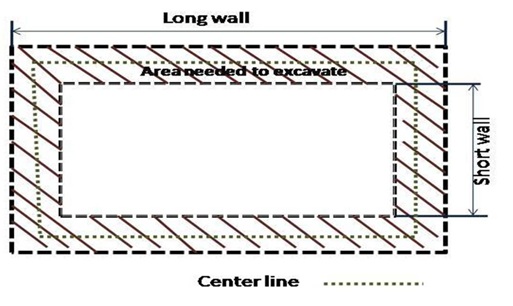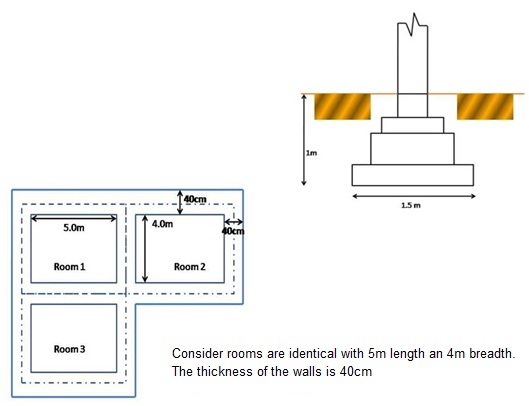INTRODUCTION
For earthwork in excavation, foundation which are symmetrical, brickwork in superstructure and plinth and concrete in foundation, two methods are there for estimation. These are-
1. Separate or Individual wall method and
2. Centre Line Method.
With these methods the lengths and widths of various items are mainly found out which helps in calculations.
SEPARATE OF INDIVIDUAL WALL METHOD
Here, the external wall length in the longitudinal direction and the internal wall length running in transverse direction are found out and quantities are calculated by multiplying the length, breadth and height of wall. Similarly, in excavation of foundation to concrete in foundation and to masonry, this method is carried out. Utmost care is taken to note the difference in dimensions at different heights due to footings or due to offsets. The length of wall in longitudinal direction is normally reduced from earth work to brick work in case of super structure whereas the wall in transverse direction is raised. Also, the wall along the length of room is taken as long wall whereas the wall perpendicular to long wall is treated as short wall.
Following formulas are used –
Long wall length out-to-out = centre to centre length + half breadth on one side + half breadth on the other side
= centre to centre length + one breadth
Short wall length in-to-in = centre to centre length – one breadth
This method is simple and accurate and is also termed as Long wall and short wall method or general method.

Fig 1: Long wall and short wall method
Courtesy: Basic Civil Engineering
CENTRE WALL METHOD
Here, sum of total length of centre walls as well as short wall and long wall has to be found out. The total length is then multiplied by breadth and height to obtain the quantity. Here, length will remain same for all items. This quicker method but special attention is needed at meeting points of walls or partitions or cross walls.
When there are numerous footings, the length of first footing is determined by deducting half breadth of footing per junction from the total centre line length and then length of that footing can be calculated by adding one offset of footing to the length of previous footing. This is not accurate method compared to long wall and short wall method but due to its quick results it is adopted as approximate results are more advantageous than accurate results in estimation.

Fig 2: Centre line method
Courtesy: Basic Civil Engineering
CENTRE LINE VS LONG WALL AND SHORT WALL METHOD
- Long wall and short wall method saves huge sum of money on big projects that as accurate results are obtained with it compared to centre line method.
- Centre line method finishes work faster as compared to long wall and short wall method as approximate calculations are involved here.
- Long wall and short wall method are simple compared to centre line method as not much complex calculations is required.
FUTURE SCOPE
Numerous software are there in market for performing such estimation methods. Estimation field has not much seen changes as early methods are still now applied. Moreover, the surveyors, contractors, estimators are till now using conventional techniques to ascertain the quantities involve. Estimation is merely a probability of ascertaining the cost and not much skills are required to perform this. In future, many software can replace human effort keeping in the accuracy as well keeping up the pace which is being somehow lacked in these times. Estimation is said to be the lifeline of civil engineering field and efforts are being made to improve it as it progresses.
REFERENCES
- Construction, “METHODS OF MEASURING QUANTITIES IN STRUCTURE”- http://www.constructionnews.co.in/methods-of-measuring-quantities.html
- CSeek, “Estimation of Building – Long Wall Short Wall, Center Line Method.”- https://civilseek.com/estimation-of-building/
- B N Dutta, “Estimating and Costing In Civil Engineering”, Twenty-Eighth Edition, UBS Publishers’ Distributors Pvt. Ltd.
If you have a query, you can ask a question here.


